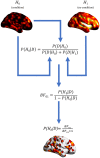BACON: A tool for reverse inference in brain activation and alteration
- PMID: 33991154
- PMCID: PMC8249901
- DOI: 10.1002/hbm.25452
BACON: A tool for reverse inference in brain activation and alteration
Abstract
Over the past decades, powerful MRI-based methods have been developed, which yield both voxel-based maps of the brain activity and anatomical variation related to different conditions. With regard to functional or structural MRI data, forward inferences try to determine which areas are involved given a mental function or a brain disorder. A major drawback of forward inference is its lack of specificity, as it suggests the involvement of brain areas that are not specific for the process/condition under investigation. Therefore, a different approach is needed to determine to what extent a given pattern of cerebral activation or alteration is specifically associated with a mental function or brain pathology. In this study, we present a new tool called BACON (Bayes fACtor mOdeliNg) for performing reverse inference both with functional and structural neuroimaging data. BACON implements the Bayes' factor and uses the activation likelihood estimation derived-maps to obtain posterior probability distributions on the evidence of specificity with regard to a particular mental function or brain pathology.
Keywords: Bayes' factor; activation likelihood estimation; coordinate-based meta-analysis; fMRI; reverse inference; voxel-based morphometry.
© 2021 The Authors. Human Brain Mapping published by Wiley Periodicals LLC.
Conflict of interest statement
The authors declare no potential conflict of interest.
Figures






References
-
- Ashburner, J. , & Friston, K. J. (2000). Voxel‐based morphometry—The methods. NeuroImage, 11(6), 805–821. - PubMed
Publication types
MeSH terms
LinkOut - more resources
Full Text Sources
Other Literature Sources
Medical
Miscellaneous

